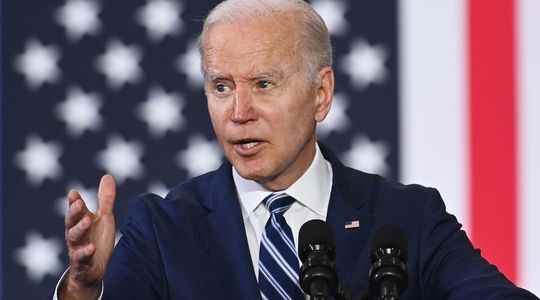The symbol is strong. On Monday May 9, US President Joe Biden signed legislation to expedite the shipment of military equipment to Ukraine, reactivating an iconic device dating from World War II. The “Ukraine Democracy Defense Lend-Lease Act”, or “lend-lease” law, is a text inspired by a program intended in its time to support Europe in the face of Hitler’s advance.
“I am signing a bill that provides another important tool that directly supports the Government of Ukraine and the people of Ukraine and their fight to defend their country and their democracy from Putin’s brutal war,” Joe Biden said from Office. oval, quoted by CNBC. The cost of struggle is not cheap, but giving in to aggression is even more costly.”
This strong act benefited from a large majority of votes in the Senate, where the Democratic president nevertheless has a narrow lead in seats. He “was supported by almost all members of Congress”, with the exception of ten elected House of Representatives who voted against, noted the White House.
This majority vote marks the overcoming of a very bipartisan vision of the United States. When other subjects, such as the Covid-19, had been able to receive a blockage from the Republican camp, “on Russia, the idea that Moscow represents a threat is very shared by a majority of elected officials and the people”, recalls Nicole Bacharan .
expanded powers
The signing of this “Ukraine Democracy Defense Lend-Lease Act of 2022” will make it easier for the United States to lend or lease military aid to allies affected by the invasion of Ukraine, launched on February 24.
If Joe Biden already had a certain latitude on the subject, this law “facilitates and accelerates the process of sending weapons on the deadlines, the type of weapons, the means of transporting them and leaves more initiatives to the president “, specifies to L’Express Nicole Bacharan, historian specializing in the United States and author of the book The Great Days That Changed America (Perrin, 2021). The financial conditions for sending weapons are also simplified. “The United States will obtain guarantees that the country will replace or refund the goods at a later date,” CNBC adds.
A symbolically strong text
The American president, with this text, sends a strong symbolic response to his Russian counterpart. Joe Biden, who regularly expresses his desire to lead the great fight of democracies against authoritarian regimes, places himself in the footsteps of Franklin D. Roosevelt. The latter had triggered in 1941, before the Americans officially entered the conflict in December, a lend-lease program giving the President of the United States extensive powers to support the war effort in Europe.
“It is historically strong because this text which was used for the last time in 1945 – without ever being repealed – had also benefited, in addition to the United Kingdom, other allies of the United States of the time, including the USSR, abounds Nicole Bacharan. And Vladimir Putin’s Russia is an heiress of this USSR.”
During the Second World War, President Roosevelt could not engage in the conflict because of the law of neutrality. The repeated appeals of Winston Churchill, British Prime Minister at the time, ended up paying off: the American head of state had then succeeded in a “sleight of hand, namely presenting this law as a metaphor for the garden hose : when your neighbour’s house burns down, you don’t wait for the flames to devour everything, you lend him the garden hose that he will return afterwards”, explains the historian. Here, for kyiv, the scenario is similar: “we must send weapons quickly, without worrying about whether Ukraine will reimburse or return the weapons sent,” she adds.
The sign of a determined commitment to Ukraine
“This law marks a very strong desire for commitment without going directly to war”, underlines the specialist from the United States. The American Congress has also taken, on Tuesday, a first step towards the release of a new staggering envelope of nearly 40 billion dollars for Ukraine, which must now be voted on in the Senate.
“With this aid program, America sends a signal to the world of our unwavering determination to support the courageous people of Ukraine until victory” against Moscow, said Nancy Pelosi, Democratic Speaker of the House of Representatives. , a few hours before this text was adopted by elected officials on both sides.
The United States, once again savior of Europe?
Once again, the United States imposes itself as the savior of the Old Continent in the face of the aggressor, even if the latter has changed its face. But questions arise, sometimes legitimately, about the American commitment to this war: “Isn’t the United States dragging Europe into a larger war and that Europe does not want?” Asks Nicole Bacharan, who points out the very different languages of European leaders compared to American leaders.
Emmanuel Macron, for example, insists on the importance of a negotiation, which “will be done neither in negation, nor in the exclusion of one another, nor even in humiliation”, he said. he said during a press conference at the European Parliament on Monday. On the other side of the Atlantic, elected officials are more direct and want a “weakened Russia”, as Antony Blinken, the US Secretary of State, said last April..
But if “the form is different, the content remains similar. This does not change much compared to the commitments of each other in Europe which are very similar, depending on the means of each”, notes the historian. Which concludes: “Russia is de facto weakened by this war, and isolated on the international scene.”
